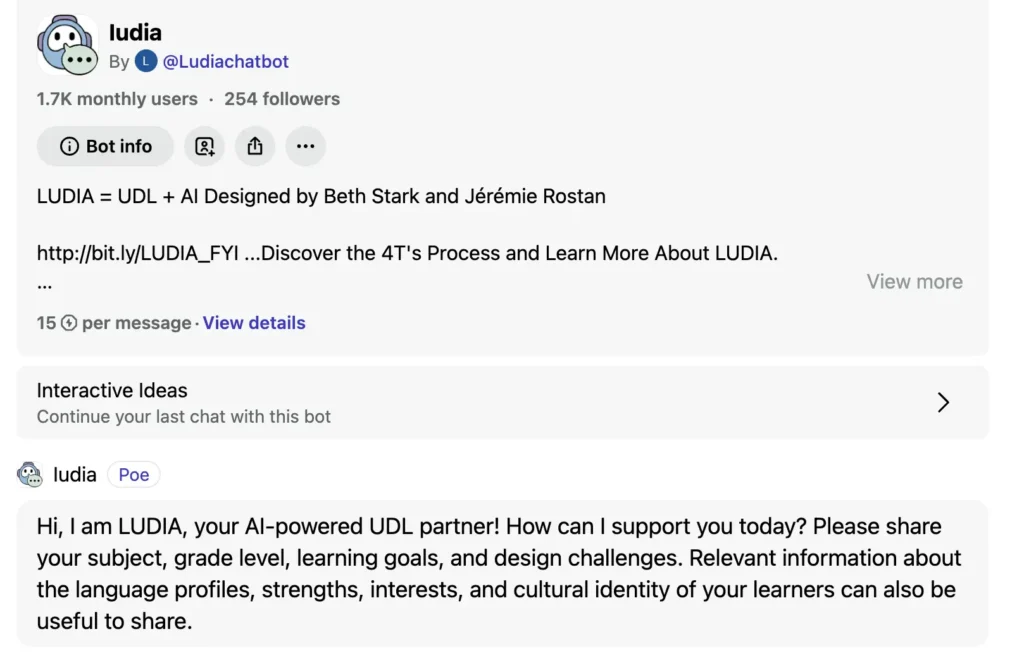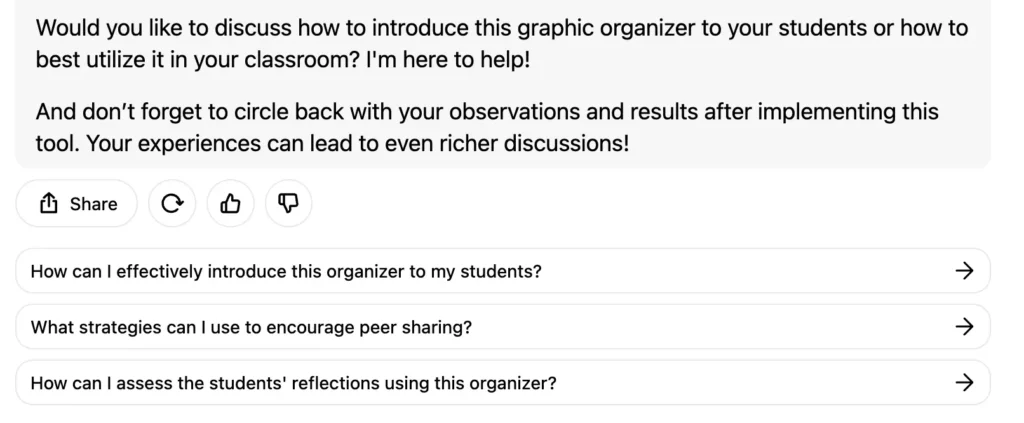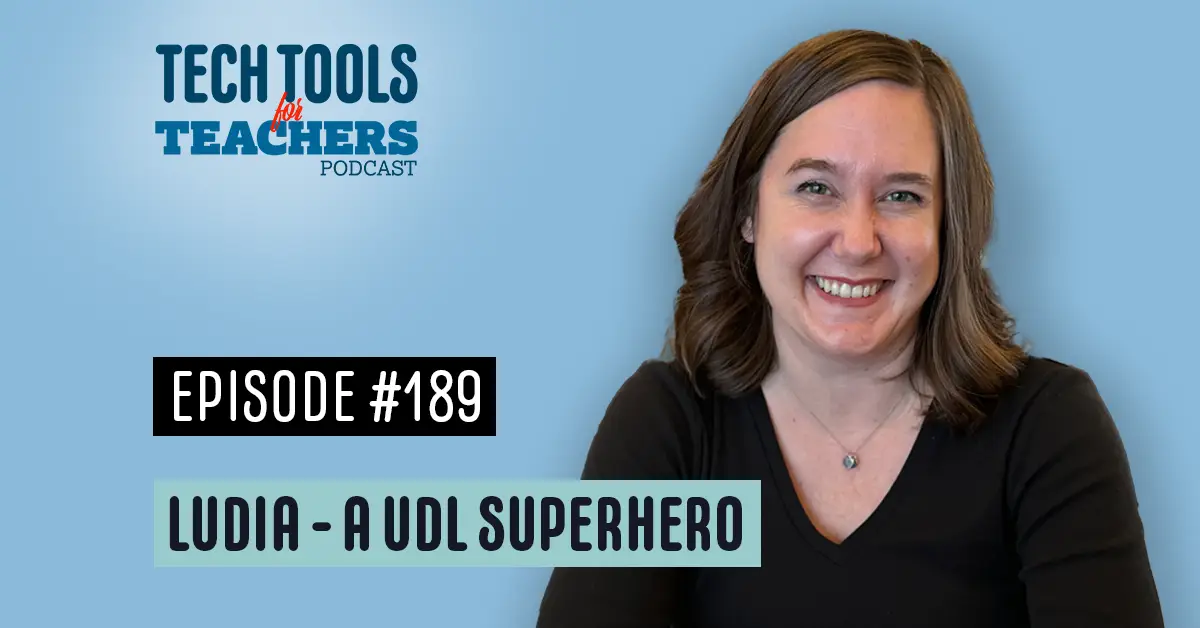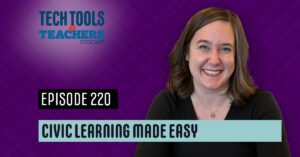[00:00:00] Shanna Martin: Thanks for listening to the Tech Tools for Teachers podcast, where each week we talk about a free piece or two of technology that you can use in your classroom. I’m your host, Shanna Martin. I’m a middle school teacher, technology, and instructional coach for my district.
[00:00:32] Fuzz Martin: And I’m her producer and husband, Fuzz Martin, and each week I help her make the show ready for airplay.
Hey, Shanna, now that you’re done just doing PD and all the kids are back in the hallways, when you walk through, are you like, Move, kids, get out the way.
I needed a pun for ludia, so I went with one. And you’re trying to go, like,
[00:00:55] Shanna Martin: Ludacris? Yeah,
[00:00:57] Fuzz Martin: there we go.
[00:00:57] Shanna Martin: Nice.
[00:00:58] Fuzz Martin: Um. It was a stretch, but that’s all I had.
[00:01:03] Shanna Martin: That’s okay. Now we need some, like, bass going, though, I feel like, for the intro.
[00:01:08] Fuzz Martin: Move, kids, get out the way.
[00:01:10] Shanna Martin: Yeah.
[00:01:11] Fuzz Martin: Yeah. Uh, anyway.
[00:01:12] Shanna Martin: We’re back. Kind
[00:01:13] Fuzz Martin: of. They’ll get better over the season, folks.
[00:01:16] Shanna Martin: It’s season seven.
[00:01:18] Fuzz Martin: Seventh season.
[00:01:19] Shanna Martin: That’s crazy. Episode 189.
[00:01:23] Fuzz Martin: 189. Which
[00:01:24] Shanna Martin: is also crazy and also super fun. We had a little summer, like, chat earlier with episode 188, but it’s been a while.
[00:01:33] Fuzz Martin: Yeah.
[00:01:34] Shanna Martin: It’s been a while. Oh man. We have all the songs today. We started singing things. We did.
[00:01:38] Fuzz Martin: We did this thing in our, with our PR team with Anytime that we sing a song like this in our PR meetings, yeah, we add it to a playlist in Spotify.
[00:01:46] Shanna Martin: Well, that’s fun. And it’s a
[00:01:47] Fuzz Martin: very interesting playlist. That
[00:01:48] Shanna Martin: would be a very fun playlist. Yeah. To listen to. So, yeah, it’s, summer’s over, we’re back in school, we’re back in action, I’ve done all the professional development for the summer and ran a bunch of things, and so with that, actually, it inspired my first West Bend, Kewaskum, Slinger, West Bend, Kewaskum, Slinger, West Bend, Kewaskum, Slinger, West Ludia,
[00:02:26] Fuzz Martin: Ludia,
[00:02:26] Shanna Martin: Ludia, which is a UDL, so Universal Design for Learning based tech tool that is a piece of AI.
And I’ll kind of explain how it works and everything, but it’s very cool. And it was a hit with the staff. So I was like, you know what? I’m going to start the season with something that I already have a bunch of people excited about. So we’re going to talk some more about it. We also decided, you and I decided, that for season seven, the setup of my podcast is, The same, but a little different.
Yes. So at the start of each chat, I’ll kind of give my top five reasons why I really like the tool.
[00:03:02] Fuzz Martin: Yes.
[00:03:03] Shanna Martin: And then I’ll go into the explanations with that. Yeah.
[00:03:06] Fuzz Martin: Five reasons why you might like this tool as well as an educator.
[00:03:10] Shanna Martin: Yes. So top five reasons, and then we’ll talk specifics.
[00:03:14] Fuzz Martin: All right, Shanna. So why, what are the top five reasons why you like Ludia?
[00:03:22] Shanna Martin: Alright, mind you, this is an A. I. Just so everyone knows and I’ll explain the website stuff a little bit, but four top five things. Why I like Ludia. Number one, It’s supported by Katie Novak, who’s the UDL trainer guru does all of the things for Novak education. And she supports the tool and finds all of the fabulous uses for it.
To me like that’s very important because she backs this tool. This piece of AI. Till! It’s really, really easy to use. You just like write all the information and it does all the work for you, which, you know, it’s a time saver. Three, it aligns with the UDL guidelines. So it is very specific. Like if you’re talking about engagement and talking about barriers and you’re talking about, so it uses the language of UDL guidelines, which is really important because it is aligned with it.
So it all makes sense. Four, it shares barriers and how to break them down. So a big piece of UDL. is talking about students barriers. So if they’re struggling with something, or just these roadblocks that you run into all the time in your classroom, how, and it tells you, here’s going to be a barrier, like it tells you the barrier.
And then it says, and these are all the ways around it.
Sure.
[00:04:37] Shanna Martin: So like, it tells you like, you’re probably, this is going to happen. And then this is how you’re going to fix it. And this tool tells you that,
which
[00:04:44] Shanna Martin: is great. It helps you like pre think as a teacher. So cool. And five, it doesn’t just stop at one suggestion.
So if it gives you some ideas and you say, Hey, but I need more reflection pieces. And it goes here, you can use using this. Do you want more information? And it gives you question prompts at the bottom to then give you the next steps or other questions to ask and gives you even more relevant information.
[00:05:08] Fuzz Martin: Perfect.
[00:05:08] Shanna Martin: There’s my top five things. Okay. Now I’m actually gonna talk about site. Now
[00:05:11] Fuzz Martin: let’s talk about
[00:05:13] Shanna Martin: Ludia. How
[00:05:13] Fuzz Martin: you got there? Yes, Ludia. How I got
[00:05:15] Shanna Martin: there?
[00:05:15] Fuzz Martin: L-U-D-I-A. Ludia?
[00:05:17] Shanna Martin: Yes. So that’s something that you need to when you pull up the site. Mm-Hmm? . It’s actually po.com/ludia.
[00:05:26] Fuzz Martin: Okay,
[00:05:27] Shanna Martin: so PO is the AI chatbot.
[00:05:29] Fuzz Martin: How do you spell po?
[00:05:30] Shanna Martin: It’s POE.
[00:05:32] Fuzz Martin: Okay. Like Edgar, Lin, like
[00:05:33] Shanna Martin: edlin po. Yeah. Dot com slash ludia. L-U-D-I-A. By the way, that’s UDL and
[00:05:41] Fuzz Martin: AI
[00:05:43] Shanna Martin: in a word together. Woo hoo! Yeah. So what’s cool about this is there was two creators that put this together.
[00:05:51] Fuzz Martin: So it was designed by Beth Stark and Jeremy Rostan, I believe it’s pronounced.
[00:05:56] Shanna Martin: I believe so.
And so they were the creators. So the Poe. com like platform lets you create different AI tools. So these two. Designed this specifically to be able to teach, like to support teachers with UDL, which is fabulous. So basically it gives you the little prompt like, hi, I’m Ludia. I’m your AI powered UDL partner.
Yeah. Hey, how can I help you today? Like a good old AI chat bot does. And what’s cool about this is when you type in the information. So I’m going to give you an example. I typed in and you can be really specific, but you don’t have to be crazy specific. So I said, I want geology. Like a geology lesson was UDL, UDL based with properties of minerals, ninth grade with lexiles of 450 to 900.
So this was actually a prompt that one of my staff members gave me in our PD that I was running. I’m like, somebody just throw this out to me. Let’s see what it does. And it starts you with potential barriers and UDL checkpoints. So already it’s going to tell you, it references the UDL guidelines. So here’s your barrier, limited engagement with textual materials.
So we already know kids probably might struggle with the text. Here’s your solution. Provide a variety of texts at different lexiles about minerals, and it gives you examples, like infographics, videos, find, that explain mineral properties, and it goes into specific details, like what to look for when you’re prepping this lesson.
Another barrier, kids may not have prior knowledge. Okay, so what can we do to know what our kids already know? It gives you like KWL charts, and, different group responses and existing understanding, things like that. And then it gives you another barrier. So, there might be limited opportunities for expression.
That would be students sharing their work. So then it gives you ideas like creating digital presentations, hands on models, doing reports, flexibility and accommodate. So it gives you all these things. Okay, so then I want to know how can I assess kids understanding. Then it gives me more information about assessment strategies and what assessments could look like.
And then I asked, can you provide examples for guiding questions for self assessment? Yes, I can. And then it gives you a literally like sets up the questions for me, like what key properties of minerals, um, other minerals I research and how well do I understand them? Like there’s your kid’s reflection prompt.
And then they explain it. And it’s really cool as this tool just keeps prompting you, like, I want more things on engagement. Cool. Here’s all these, here’s six, five different ways to set up engagement. And then I said, can you create a graphic organizer to support and enhance the discussion? Yes. Here’s a self assessment reflective organizer.
It doesn’t physically make the organizer, but it gives you the questions to prompt. To set up your organizer gives you the section breakdown, between like project execution, skills developed, and then it gives kids adaptations for feedback. So it just keeps on going. And then at the very bottom, after giving me all this information to set up a lesson for my kids, it goes.
How can I effectively introduce this organizer for my students? Do I want to know that more? Click on that. It’ll give me more information. I can ask what strategies can I use to encourage peer sharing? It will give me a whole nother setup. Can I assess students reflections using this organizer? Here’s a whole nother setup.
So it just keeps. Leading and building on UDL guidelines specific content areas or you can put in your specific content or targets you want students to learn as well a and it’s super cool. Yeah. So
we’re
[00:09:25] Fuzz Martin: going
[00:09:25] Shanna Martin: Because it follows everything you need it to to set up like a guided UDL lesson.
[00:09:30] Fuzz Martin: Sure, and it’s all right there and and quickly, right?
[00:09:33] Shanna Martin: Very quick, so like, I’m going to throw in a new chat just for the fun of it while we are chatting. I’m gonna put in,
mm hmm,
[00:09:41] Shanna Martin: fourth grade, ELA, comparison writing example, let’s see, three different reading levels.
[00:09:52] Fuzz Martin: Okay.
[00:09:54] Shanna Martin: And it will produce, I click the little arrow. You also have an audio button there. So you can actually click the microphone and just talk at it.
And I’m worried for you too. Great. In line with UDL. Here we go. Engagement with text gives you it’s UDL 2. 2 with checkpoint 2. 1. Students may find it difficult to engage with texts. Here’s your barriers. Here’s a solution. Provide texts that are culturally relevant and high interest. Like it already like sets you up.
Here’s your barriers. and then which solutions do you want to go with? And I’ll circle back with observations and results if you want it, so. Again, it just continues to build your lessons and support the information that you need., Which is really cool. And then once you have it all set up, n click the little copy and share link and share it out. Yay, copied! So I can send that to myself in an email or send it to my team. So if you’re planning together, you can be like, Hey, all right, we’ve got different groups of kids, but we’re all teaching the same thing.
These are some barriers we might run into when we’re planning. Let’s talk about how we can make this happen in our classrooms.
[00:11:01] Fuzz Martin: Very cool. And
[00:11:01] Shanna Martin: it’s like done.
[00:11:02] Fuzz Martin: So is there any limit to this with Ludia? Yeah.
[00:11:07] Shanna Martin: I have not run into any limits yet. How’s that? So I just keep going and planning and going. And on the left hand side of the screen, it keeps my chats.
So, like I can go back to my geology lesson. I have typed in interactive ideas. I’ve done lessons on textual evidence. I did one on mapping skills, so it keeps my chats in the left hand side of my screen. So I keep collecting them so I can go back to my resources as needed. You just log
[00:11:34] Fuzz Martin: in with your email address?
[00:11:36] Shanna Martin: Yep, I just use my Google email address. Okay. And then I can share it out. My chat or if Ludia as needed.
[00:11:43] Fuzz Martin: Okay.
[00:11:44] Shanna Martin: So it’s all run through Poe, you know, E because then they also have like create a chat bot actually, and you have an option to like make your own. So that’s, that’ll be a whole nother day of creating chat bots, but this is all.
Fabulous. And it’s UDL aligned and it’s been out for about a year now. So what I appreciate is a lot of the bugs have kind of been worked out and it’s pretty accurate with what you’re looking for when it’s aligning with UDL, guidelines and things like that. And it’s super cool and super useful. And you can just take bits and pieces of it.
Cause a lot of things like we’ve been teaching for a long time, or even if you’re new and you’ve got some background, this just helps you plan and set up. And strategically think about how you’re setting up your stuff. So it’s pretty fantastic. And our, my staff was very excited to like, play around with this one and test this one out
[00:12:34] Fuzz Martin: free.
No paywalls. There you go.
[00:12:36] Shanna Martin: Yeah. Ludia.
[00:12:38] Fuzz Martin: Wonderful.
[00:12:39] Shanna Martin: UDL. And AI together.
[00:12:41] Fuzz Martin: Yes. Great job!
[00:12:43] Shanna Martin: Yeah! I’m really excited, and I’m really excited to continue using it throughout the year, not just kind of play around with it here and there, but like, make sure that my lessons are set up. This is going
[00:12:51] Fuzz Martin: into your everyday workflow.
It’s going to go into
[00:12:53] Shanna Martin: my everyday, yeah. I have a few tools that I use all of the time, and this will definitely be one of them. Especially with just making sure my structures are there. Like, I can’t always think of every barrier that I come across. So, I think that that will be very helpful for my students.
Yeah.
[00:13:08] Fuzz Martin: Yeah.
[00:13:09] Shanna Martin: Pretty excited. Excited to kick off Season 7 with this one.
[00:13:13] Fuzz Martin: Yeah, me too.
[00:13:14] Shanna Martin: Yay. Well, thanks for tuning in. This has been the Tech Tools for Teachers podcast. If you ever have any questions, you can find me on the app formerly known as Twitter or at smartinwi at Smart and WI or on threads or on Facebook.
Or on SmartinWI. com or on Instagram. Like we are everywhere at this point. If you want to get more information on the links to the technology discussed in this episode, you can visit SmartinWI. com. If you liked this report to show, please consider buying me a coffee or two. Visit BuyMeACoffee. com slash SmartinWI or visit SmartinWI.
com and click on that cute little purple coffee cup. Your donations help keep the show going. So nice to be back here and chatting with all of you. New episodes each week. Thanks for listening. Go educate and innovate.
[00:14:03] Fuzz Martin: The ideas and opinions expressed on this podcast and the smartinwi.com website are those of the author, Shanna Martin, and not of her employer.
Prior to using any of the technologies discussed on this podcast, Please consult with your employer regulations. This podcast offers no guarantee that these tools will work for you as described, but we hope they do. That’s why we do this show. And we’ll talk to you next time, right here on the tech tools for teachers podcast.








